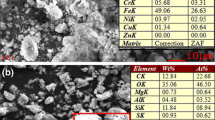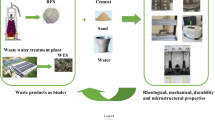Abstract
Treatment of textile industry effluents produces hazardous sludge. The improper disposal of sludge causes secondary pollution due to the leaching of heavy metals from it. Therefore, the prerequisite for the disposal of such hazardous sludge is its stabilization and solidification. The utilization of sludge as a resource for building materials is one of the sustainable solutions. The present study evaluates the feasibility of partially substituting cement with the textile common effluent treatment plant (TCETP) sludge and mineral admixture such as sugarcane bagasse ash (SBA) in cement mortar mixes. The 13 mortar mixes are prepared consisting of a control mix, four binary mixes with sludge (2.5, 5, 7.5, and 10%) and eight tertiary mixes with sludge (2.5, 5, 7.5, and 10%) and SBA (5, 10%) replacing cement by volume. Few binary and tertiary blended cement mortar mixes have demonstrated comparable strength, permeation, durability, and leaching properties that are on par with the control mix. The modified mortar mixes 2.5T, 5T, 2.5T5S, 5T5S, and 7.5T5S have improved strength compared to 7.5T, 10T, 10T5S, 2.5T10S, 5T10S, 7.5T10S, and 10T10S. Increased strength in mortar mixes is mainly attributable to the filler effect of sludge and SBA and the development of secondary CSH gel. The mortar mixes 7.5T, 10T, 10T5S, 2.5T10S, 5T10S, 7.5T10S, and 10T10S have increased sorptivity indices showing the presence of large-size pores. Durability results suggest a loss in strength due to sulfate attack. Carbonation is not observed in the mixes, and all the mixes are alkaline. However, the leaching study shows the presence of heavy metals in leachate solution above the permissible limit, mainly with mixes having 10% sludge and is within the permissible limit for all other mixes. The SEM image and XRD fingerprint analysis revealed the formation of porous structure and a reduction in CSH gel formation at higher replacement by sludge and SBA.
Graphical abstract


















Similar content being viewed by others
Data availability
All required data supporting the findings are available in the manuscript. If the readers require any additional data, the same would be shared electronically by the authors whenever required.
Abbreviations
- ASTM:
-
American standard of testing and materials
- BET:
-
Brunauer–Emmett–Teller
- BIS:
-
Bureau of Indian Standards
- CETP:
-
Common effluent treatment plant
- CH:
-
Calcium hydroxide
- CM:
-
Control mix
- CSH:
-
Calcium silicate hydrate
- E:
-
Ettringite
- FE-SEM:
-
Field emission scanning electron microscopy
- ICP-OES:
-
Inductively coupled plasma-optical emission spectroscopy
- IS:
-
Indian Standard
- OPC:
-
Ordinary Portland cement
- Q:
-
Quartz
- SBA:
-
Sugarcane bagasse ash
- SEM:
-
Scanning electron microscope
- TCETP:
-
Textile Common Effluent Treatment Plant
- TCLP:
-
Toxicity characteristics leaching procedure
- US EPA:
-
United States Environment Protection Agency
- V:
-
Voids
- XRD:
-
X-ray diffraction
- XRF:
-
X-ray fluorescence
References
Goyal S, Siddique R, Sharma D, Jain G (2022) Reutilization of textile sludge stabilised with low grade-MgO as a replacement of cement in mortars. Constr Build Mater 338(2021):127643. https://doi.org/10.1016/j.conbuildmat.2022.127643
Solanki DP (2017) A role of textile industry in Indian economy. Natl J Adv Res 3(3):60–65
Patel H, Pandey S (2012) Evaluation of physical stability and leachability of Portland Pozzolona Cement (PPC) solidified chemical sludge generated from textile wastewater treatment plants. J Hazard Mater 207–208:56–64. https://doi.org/10.1016/j.jhazmat.2011.05.028
Beshah DA, Tiruye GA, Mekonnen YS (2021) Characterisation and recycling of textile sludge for energy-efficient brick production in Ethiopia. Environ Sci Pollut Res 28(13):16272–16281. https://doi.org/10.1007/s11356-020-11878-7
Velumani P, Senthilkumar S (2018) Production of sludge-incorporated paver blocks for efficient waste management. J Air Waste Manag Assoc 68(6):626–636. https://doi.org/10.1080/10962247.2017.1395373
Anwar TB, Behrose B, Ahmed S (2018) Utilisation of textile sludge and public health risk assessment in Bangladesh. Sustain Environ Res 28(5):228–233. https://doi.org/10.1016/j.serj.2018.04.003
Shathika Sulthana Begum B, Gandhimathi R, Ramesh ST, Nidheesh PV (2013) Utilisation of textile effluent wastewater treatment plant sludge as brick material. J Mater Cycles Waste Manag 15(4):564–570. https://doi.org/10.1007/s10163-013-0139-4
Goyal S, Siddique R, Jha S, Sharma D (2019) Utilisation of textile sludge in cement mortar and paste. Constr Build Mater 214:169–177. https://doi.org/10.1016/j.conbuildmat.2019.04.023
Zhan BJ, Poon CS (2015) Study on feasibility of reutilising textile effluent sludge for producing concrete blocks. J Clean Prod 101:174–179. https://doi.org/10.1016/j.jclepro.2015.03.083
Raghunathan T, Gopalsamy P, Elangovan R (2010) Study on strength of concrete with ETP sludge from dyeing industry. Int J Civ Struct Eng 1(3):379–389
Rahman MM, Khan MMR, Uddin MT, Islam MA (2017) Textile Effluent treatment plant sludge: characterisation and utilisation in building materials. Arab J Sci Eng 42(4):1435–1442. https://doi.org/10.1007/s13369-016-2298-9
Zhan BJ, Li JS, Xuan DX, Poon CS (2020) Recycling hazardous textile effluent sludge in cement-based construction materials: physicochemical interactions between sludge and cement. J Hazard Mater 381(2018). https://doi.org/10.1016/j.jhazmat.2019.121034
Minnu SN, Bahurudeen A, Athira G (2021) Comparison of sugarcane bagasse ash with fly ash and slag: an approach towards industrial acceptance of sugar industry waste in cleaner production of cement. J Clean Prod 285(xxxx):124836. https://doi.org/10.1016/j.jclepro.2020.124836
Xu Q, Ji T, Gao SJ, Yang Z, Wu N (2018) Characteristics and applications of sugar cane bagasse ash waste in cementitious materials. Materials 12(1):1–19. https://doi.org/10.3390/ma12010039
Batool F, Masood A, Ali M (2020) Characterisation of sugarcane bagasse ash as pozzolan and influence on concrete properties. Arab J Sci Eng 45(5):3891–3900. https://doi.org/10.1007/s13369-019-04301-y
Gupta CK, Sachan A, Kumar R (2022) Utilisation of sugarcane bagasse ash in mortar and concrete: a review. Mater Today Proc xxxx. https://doi.org/10.1016/j.matpr.2022.03.304
Gupta CK, Sachan AK, Kumar R (2021) Examination of microstructure of sugar cane bagasse ash and sugar cane bagasse ash blended cement mortar. Sugar Tech 23(3):651–660. https://doi.org/10.1007/s12355-020-00934-8
Chi MC (2012) Effects of sugar cane bagasse ash as a cement replacement on properties of mortars. Sci Eng Compos Mater 19(3):279–285. https://doi.org/10.1515/secm-2012-0014
Mohan R, Athira G, Mali AK, Bahurudeen A, Nanthagopalan P (2021) Systematic pretreatment process and optimization of sugarcane bagasse ash dosage for use in cement-based products. J Mater Civ Eng 33(4):04021045. https://doi.org/10.1061/(asce)mt.1943-5533.0003650
Nassar RUD, Singh N, Varsha S, Sai AR, Sufyan-Ud-Din M (2022) Strength, electrical resistivity and sulfate attack resistance of blended mortars produced with agriculture waste ashes. Case Stud Constr Mater 16(2021):e00944. https://doi.org/10.1016/j.cscm.2022.e00944
Quedou PG, Wirquin E, Bokhoree C (2021) Sustainable concrete: Potency of sugarcane bagasse ash as a cementitious material in the construction industry. Case Stud Constr Mater 14. https://doi.org/10.1016/j.cscm.2021.e00545
IS: 8112 (2013) Indian standards for 43 grade ordinary portland cement- specification, second revision. Bureau of Indian Standards, New Delhi, p 17
Patil C, Manjunath M, Hosamane S, Bandekar S, Athani R (2020) Pozzolonic activity and strength activity index of bagasse ash and fly ash blended cement mortar. Mater Today Proc 42:1456–1461. https://doi.org/10.1016/j.matpr.2021.01.251
IS: 4031 (part 11) (1988) Methods of physical tests for hydraulic cement. Bureau of Indian Standards, pp 1–6
IS: 650 (1991) Indian specification for standard sand for testing of cement. Indian Standards, pp 1–11
IS: 456 (2000) Indian standard for plain concrete and reinforced concrete- code of practice (Fourth Revision). Bureau of Indian Standards, New Delhi, pp 1–114
IS: 4031 (Part 8) (2005) Indian standard methods of physical test for hydraulic cement- determination of transverse and compressive strength of plastic mortar using prism. Bureau of Indian Standard, New Delhi, pp 1–9
IS: 4031 (Part 4) (1988) Indian standard methods of physical tests for hydraulic cement: determination of consistency of standard cement paste, reaffirmed 2013. Bureau of Indian Standard, New Delhi
IS: 4031 (Part 6), (1988) Indian standard methods of physical tests for hydraulic cement- determination of compressive strength of hydraulic cement other than masonry cement, first revision. Bureau of Indian Standards, New Delhi, pp 1–3
Abraham SM, Ransinchung GD (2019) Effects of reclaimed asphalt pavement aggregates and mineral admixtures on pore structure, mechanical and durability properties of cement mortar. Constr Build Mater 216:202–213. https://doi.org/10.1016/j.conbuildmat.2019.05.011
ASTM C78 (2019) Standard test method for flexural strength of concrete (using simple beam with third-point loading). ASTM International, pp 1–4
ASTM C1585 (2013) Standard test method for measurement of rate of absorption of water by hydraulic cement concretes. ASTM International, pp 1–6
ASTM C1012 (2004) StandardStandard test method for length change of hydraulic-cement mortars exposed to a sulfate solution. ASTM International, pp 1–6
Abraham SM, Ransinchung GDRN (2022) Durability performance of cementitious mixes with reclaimed asphalt pavement aggregates. Transp Dev Econ 8(1):1–8. https://doi.org/10.1007/s40890-021-00126-3
US EPA (1992) Toxicity characteristics leaching procedure. July, pp 1–35
BIS (2012) Indian standard drinking water specification (second revision). Bureau of Indian Standards, IS 10500 (May):1–11. http://cgwb.gov.in/Documents/WQ-standards.pdf
Balasubramanian J, Sabumon PC, Lazar JU, Ilangovan R (2006) Reuse of textile effluent treatment plant sludge in building materials. Waste Manage 26(1):22–28. https://doi.org/10.1016/j.wasman.2005.01.011
Arenas-Piedrahita JC, Montes-García P, Mendoza-Rangel JM, López Calvo HZ, Valdez-Tamez PL, Martínez-Reyes J (2016) Mechanical and durability properties of mortars prepared with untreated sugarcane bagasse ash and untreated fly ash. Constr Build Mater 105:69–81. https://doi.org/10.1016/j.conbuildmat.2015.12.047
Bahurudeen A, Kanraj D, Gokul Dev V, Santhanam M (2015) Performance evaluation of sugarcane bagasse ash blended cement in concrete. Cement Concr Compos 59:77–88. https://doi.org/10.1016/j.cemconcomp.2015.03.004
Singh M, Adhikari A, Maurya MK, Srivastava A, Chhabra RS (2020) Feasibility study on use of washed-reclaimed asphalt as a partial replacement of natural aggregate in dry-lean concrete as base course for rigid pavement. J Mater Civ Eng 32(9):04020266. https://doi.org/10.1061/(asce)mt.1943-5533.0003339
De Weerdt K, Plusquellec G, Belda Revert A, Geiker MR, Lothenbach B (2019) Effect of carbonation on the pore solution of mortar. Cem Concr Res 118:38–56. https://doi.org/10.1016/j.cemconres.2019.02.004
Raheem A, Sikarwar VS, He J, Dastyar W, Dionysiou DD, Wang W, Zhao M (2018) Opportunities and challenges in sustainable treatment and resource reuse of sewage sludge: a review. Chem Eng J 337:616–641
Agarwal S, Singh AP (2023) Assessment of toxicity characteristics in leachate from the textile industry-based sludge using leachate pollution index. Water Air Soil Pollut 234(12):774. https://doi.org/10.1007/s11270-023-06785-9
Acknowledgments
The authors thank their parent organization BITS Pilani, India for providing the necessary facilities to carry out this research work. Thanks are due to the Advanced Research Laboratory in Environmental Engineering and Faecal Sludge Management (ARLEE-FSM) of the Civil Engineering Department, BITS Pilani, India.
Funding
There is no financial funding.
Author information
Authors and Affiliations
Contributions
SA: Conceptualization, Methodology, Data Collection, Analysis, Data Interpretation, Investigation and Modeling, Investigation, Analysis, Writing. APS: Conceptualization, Visualization, Modeling and Analysis, Supervision, Editing, Correspondence.
Corresponding author
Ethics declarations
Conflict of interest
The authors declare that there are no personal relationships or known competing financial interests that could have influenced the work reported in this manuscript.
Consent for publication
Not applicable.
Additional information
Publisher's Note
Springer Nature remains neutral with regard to jurisdictional claims in published maps and institutional affiliations.
Rights and permissions
Springer Nature or its licensor (e.g. a society or other partner) holds exclusive rights to this article under a publishing agreement with the author(s) or other rightsholder(s); author self-archiving of the accepted manuscript version of this article is solely governed by the terms of such publishing agreement and applicable law.
About this article
Cite this article
Agarwal, S., Singh, A.P. Effective reutilization of textile sludge from common effluent treatment plant with mineral admixture as a partial replacement for cement in mortar mixes. J Mater Cycles Waste Manag (2024). https://doi.org/10.1007/s10163-024-01970-2
Received:
Accepted:
Published:
DOI: https://doi.org/10.1007/s10163-024-01970-2




